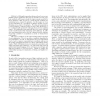51 search results - page 10 / 11 » Automatic Verification of Sequential Circuit Designs |
ICCAD
1998
IEEE
13 years 11 months ago
1998
IEEE
Abstract Althoughtremendousadvanceshave been accomplished in logic synthesis in the past two decades, in some cases logic synthesis still cannot attain the improvements possible by...
SIGSOFT
2007
ACM
14 years 7 months ago
2007
ACM
Asynchronous systems components are hard to write, hard to reason about, and (not coincidentally) hard to mechanically verify. In order to achieve high performance, asynchronous c...
TCAD
2010
13 years 1 months ago
2010
The growing complexity of systems and their implementation into silicon encourages designers to look for model designs at higher levels of abstraction and then incrementally build ...
TASLP
2002
13 years 6 months ago
2002
When automatic speech recognition (ASR) and speaker verification (SV) are applied in adverse acoustic environments, endpoint detection and energy normalization can be crucial to th...
DAC
2008
ACM
13 years 8 months ago
2008
ACM
Clock skew scheduling has been traditionally considered as a tool for improving the clock period in a sequential circuit. Timing slack is "stolen" from fast combinationa...

